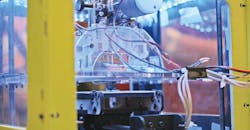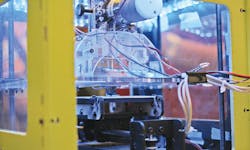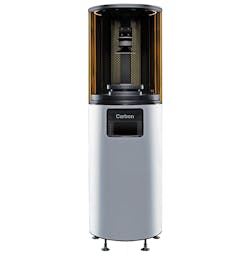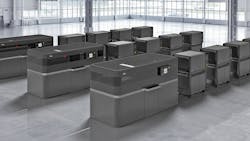The Need for Speed: 3D-Printer Manufacturers Eye Mass Production
Download this article in PDF format.
Additive manufacturing, more commonly known as 3D printing, has been around since the early 1980s—it’s a prototyping dream machine. The process (mainly stereolithography) of producing a single part back then was both time-consuming and expensive, not to mention limited regarding materials, which were mainly polymers and plastics. Additive manufacturing has evolved substantially over the last 30 years—3D printers have transitioned over to the private sector where makers and small businesses can take advantage of the technology for rapid prototyping.
More 3D manufacturers are developing platforms with increased speed and precision to tackle industry demands. (Image credit: Flickr)
They’ve become more robust with new designs being made of metals such as aluminum and steel. And they now take advantage of a plethora of printing methods that move beyond stereolithography, including digital light processing (DLP), fused deposition modeling (DLP), selective laser sintering (SLS), selective laser melting (SLM), and electronic beam melting (EBM). With these new methods comes a host of new materials that move beyond what was available in the 1980s: nylon, ABS, PLM, ceramics, gypsum, titanium, and other metals are all in the mix.
With that being said, one drawback of using additive-manufacturing technology is the issue of speed. It takes time to 3D-print objects and parts depending on the machine and materials, which can last a few hours to a few days or more. The machine bed dictates the size of what can be printed. For example, a MakerBot Replicator+ has a maximum build volume of 11.61 × 7.68 × 6.5 in., so anything larger will have to be printed in several pieces or more, which takes more time than a single print.
Other time-consuming factors include material replacement, calibrating the print-bed alignment, changing software settings, and porting CAD files to the machine. And that doesn’t take into account a host of problems that can go wrong during the print.
MakerGear’s M2 is as near a plug-and-play machine as you can get: Connect the machine via USB, run the initial setup, upload your 3D model, and the machine does the rest. (Image credit: MakerGear)
Shrinking the Printing Time
Some of the more notable 3D-printer manufacturers have been developing ways to cut down on the amount of time it takes to produce a completed print via new designs and technology. Companies such as XYZ Printing and 3D Systems have created cartridge-based filaments that snap into the chassis and are ready to go. These negate the need for using spool-based filaments, which must be manually fed during change-outs, thereby shaving minutes off print times.
Others, such as TierTime, Tevo, Prusa Research, and Ultimaker, have gone the AIO (all-in-one) route for easy plug-and-play or click-and-print options. The idea behind these platforms is to make them as easy as possible to operate. Users simply provide power, run the initial setup software, and upload their designs; the printer does the rest, automating everything from design file conversion to finished print.
All of these companies are looking to develop platforms that trim production time while increasing the amount of materials they can use. Automating nearly every process makes them attractive solutions for makers and small businesses that rely on rapid prototyping to get their products to market.
Mass Appeal
The manufacturing industry, on the other hand, relies on the mass production of parts or other items. As a result, most of the aforementioned additive-manufacturing platforms aren’t viable options. Even though they cut down on the time it takes to produce a print, it’s not nearly fast enough for churning out batches of any one item. And, while there’s some median level of post-processing (in terms of print resolution) using those platforms, it’s still not enough for producing a finished product.
But what if I told you there are additive manufacturing platform now in development that could go beyond simple, rapid prototyping by actually being able to move on to production roll?
The Carbon M2 uses CLIP technology to produce objects nearly 100X faster than conventional 3D printers. (Image credit: Carbon)
Technology startup Carbon is one of those companies looking to turn 3D-printing technology into a tool for mass production with its M1 and M2 platforms. Last year, the company launched the M1, a unique 3D printer that leverages stereolithography to grow objects using ultraviolet light and photopolymer resin.
That may seem fairly unremarkable on the surface, since other platforms use the same additive-manufacturing method. However, Carbon introduced a new technology known as CLIP (Continuous Liquid Interface Production), which allows the machine to print in a steady stream rather than layer by layer. This allows the printer to produce completed prints 100X faster than traditional stereolithography-based platforms.
Carbon has since developed the M2, which is a larger version of the M1. It has twice the build area (7.4 × 4.6 × 12.8 in. versus 5.5 × 3 × 12 in.) along with a built-in finishing unit called the Smart Part Washer, which removes any extra resin from the finished parts. What makes the M2 a great platform for the manufacturing industry is its ability to be connected to multiple units for mass production.
The technology is known as SpeedCell, a platform Carbon describes as “a system of connected unit operations that enables the repeatable production of end-use parts at any scale.” Ultimately, this allows manufacturing industries to scale their operations and deliver finished parts under a common manufacturing workflow.
Carbon’s innovation doesn’t end there, as the company says the new M2 will allow users to also sterilize their parts for use in industries such as food and medical. Not only will this technology help minimize production time, but it will also reduce labor costs.
The SpeedCell technology will be in two formats for release. Design SpeedCell is for designers and engineers who need rapid prototyping over anything else; it supports only one M2/M1 platform. Production SpeedCell is aimed at manufacturers employing two or more platforms for production. Both come with the Smart Part Washer technology. The company offers a bulk RPU 70 (rigid polyurethane) resin package for the Production version, and has designed an MMD (Meter Mix and Dispense) module that pumps a constant supply of resin (by the liter) for continuous production without the need for having to constantly switch out containers.
Ford and Adidas are two companies who have already signed on with Carbon—they will essentially incorporate the 3D-printing process into their manufacturing processes. Adidas plans on implementing Carbon’s technology to scale its production in order to mass-produce midsoles for the Futurecraft 4D line of footwear, while Ford plans to use it for automotive applications. Carbon has also introduced its 3D-printing technology to companies across Europe, such as Citim, Fast Radius, Oechsler, and Paragon, making the company’s vision for additive manufacturing a global endeavor.
Metal En Masse
Another great offering for mass production using additive manufacturing is the Studio and Production line of 3D printers from Desktop Metal. Instead of utilizing strictly polymer resins like the Carbon M2, the Studio and Production models rely on metals as their medium of choice. And like the M2, they’re able to produce finished prints very quickly—at least 100X faster than traditional metal machines.
Shown is the Desktop Metal Production system facility. (Image credit: Desktop Metal via press kit)
The Studio functions similarly to most 3D-printing machines in that it prints metal layer by layer, rather than using the subtractive method commonly found with other metal-based printers. The metals used by the machine are powdered and in rod form, bound together with a polymer binding. That means the machine extrudes into the form desired, similar to that of a fused-deposition-modeling (FDM) printer. More accurately, the binder is extruded with the metal powder encased inside. Once the desired shape is formed, the design is moved into a de-binding bath to remove most of the excess material.
After completion of the bath process, the design is placed into a specially designed microwave oven to undergo the sintering process. This makes the design more dense (about 99.8%) and burns off any excess binding material, leaving behind a robust, newly formed part that can be produced in as little as an hour. As far as materials are concerned, the Studio work with aluminum, copper, bronze, stainless steel, and 200 other alloys, which suits it well for engineers and small businesses needing a machine for rapid prototyping.
The Production system, on the other hand, was designed with speed in mind for production of multiple parts on a scale never seen before. To put that into perspective, it’s faster than casting, machining or forging, and can produce 500 cubic inches of complex parts per hour with absolutely zero tooling. The Production differs from the Studio in that it forgoes the bound rod material with an unbound powder solution.
These MIM-based metal powders are bound together during the printing process by spraying a binding solution as it goes, thereby forming the design within the binding agent. It’s then cleaned of any excess material before heading into the microwave furnace. To scale up to production speed, you’ll need four of them chained together for maximum potential.
The Studio version is available now, and the Production model is slated for release in 2018. While the platform will not replace traditional manufacturing methods anytime soon, it’s still a good footing and a great option for manufacturers to incorporate into their production lines, even if only for custom options.
The SPEE3D uses a supersonic deposition method to create metal parts in a mere 10 minutes. (Image credit: SPEED3D)
The SPEE3D 3D printer, developed by the company of the same name, is also capable of mass-producing metal prints, although the process is rather unusual: It employs a supersonic deposition method to fuse metallic powders together using sheer kinetic energy. The process is similar to the U.S. Army’s Cold Spray method of material bonding, where metal particles are placed within a heated (100-500°C) nitrogen or helium stream and shot out of a high-pressure nozzle at incredible velocities, thereby bonding them to a metal substrate.
SPEE3D calls its method “supersonic 3D deposition,” which mimics the Army’s version. A rocket nozzle accelerates the gas to 3X the speed of sound, and injected polymers are deposited onto a metal substrate that’s controlled by a six-axis robotic arm, which provides a range of motion to print any number of 3D objects.
No heat is used to build objects, only pure kinetic energy. However, it does have drawbacks—it can only take advantage of copper and aluminum, and is incapable of producing complex shapes such as lattice patterns. Instead, SPEE3D is marketing its printer for those who need to print objects with considerable weight, from half a kilogram to 10 kg. Primary targets are companies that rely on casting operations, such as in the automotive and aerospace industries, where quick turnover production is essential to getting the parts to market.
Conclusion
These represent just a few of the 3D-printer manufacturers looking to break into the mass-production industries, where speed is the key to producing parts in quantity. The idea of using a 3D printer for mass production was unheard of only a few years ago, but technologies have advanced to the point where speed and innovation have unlocked new avenues to merge the two for exciting new possibilities. True wide-scale adoption of 3D printers in the manufacturing industry isn’t yet here, but the potential these machines bring the industry will certainly cement them into the production line in the not-so-distant future.
Here’s a thought. Speed is relative. Let’s say you have a 3D printer that takes 30 hours to make one part. If you had 30 3D printers, you could make 30 parts in that same time span. Or one part an hour, relatively speaking.
About the Author
Cabe Atwell
Engineer, Machinist, Maker, Writer. A graduate Electrical Engineer actively plying his expertise in the industry and at his company, Gunhead. When not designing/building, he creates a steady torrent of projects and content in the media world. Many of his projects and articles are online at element14 & SolidSmack, industry-focused work at EETimes & EDN, and offbeat articles at Make Magazine. Currently, you can find him hosting webinars and contributing to Penton’s Electronic Design and Machine Design.






